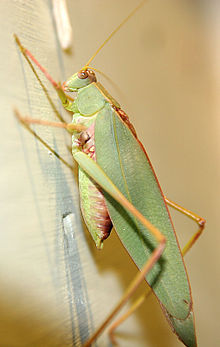Ensifera
| Ensifera | |
|---|---|

| |
| Scientific classification | |
| Domain: | Eukaryota |
| Kingdom: | Animalia |
| Phylum: | Arthropoda |
| Class: | Insecta |
| Order: | Orthoptera |
| Suborder: | Ensifera |
| Superfamilies and families | |
|
See text | |
Ensifera is a suborder of the order Orthoptera, including insects in the families Gryllidae (true crickets), Prophalangopsidae (grigs), Stenopelmatidae (Jerusalem crickets, king crickets, tree and giant wetas), Gryllacrididae (leaf-rolling and raspy crickets), Cooloolidae (cooloola monsters), Rhaphidophoridae (cave and camel crickets), Schizodactylidae (dune or splay-footed crickets) and Tettigoniidae (bush crickets or katydids). The Tettigoniidae are sometimes known as the long-horned grasshoppers to distinguish them from the other suborder of Orthoptera, the Caelifera or short-horned grasshoppers. Ensifera is believed to be a more ancient group than Caelifera, with its origins in the Carboniferous period,[1] the split having occurred at the end of the Permian period.[2]
"Ensifer" means "sword bearer" in Latin, and refers to the typically elongated and blade-like ovipositor of the females.[3]
Characteristics
Characteristics shared by the two orthopteran orders, Caelifera and Ensifera, are the mouthparts adapted for biting and chewing, the modified prothorax, the hind legs modified for jumping, the wing shape and venation and the sound-producing stridulatory organs.[1]
Ensiferans are distinguished from Caeliferans by their elongated, threadlike antennae, which are often longer than the length of their body and have over thirty segments (except in the subterranean Cooloolidae family). In the families in which the males sing, the forewings have modifications which include toothed veins and scrapers for making the noise, and the surrounding membranous areas amplify the sound. In these groups, the sound-detecting tympanal organs are located on the tibiae of the front legs.[4] The tarsi have three segments and the ovipositor is blade-like or needle-like. The male attaches the spermatophore externally to the female's gonopore. The spermatophore is often surrounded by a proteinaceous spermatophylax, the function of which is to provide a nutritional nuptial gift to the female.[4][5]
Taxonomy




The Orthoptera Species File database lists the following superfamilies and families:[6]
- Infraorder Elcanidea †
- Superfamily Elcanoidea †
- Superfamily Permoraphidioidea †
- Infraorder Oedischiidea †
- Superfamily Oedischioidea †
- Superfamily Triassomantoidea †
- Superfamily Xenopteroidea †
- Infraorder Tettigoniidea
- Superfamily Hagloidea
- Superfamily Phasmomimoidea †
- Superfamily Stenopelmatoidea
- Family Anostostomatidae - wetas, king crickets
- Family Cooloolidae
- Family Gryllacrididae - leaf-rolling crickets
- Family Stenopelmatidae - Jerusalem crickets
- Superfamily Tettigonioidea (or Tettigoniidae) - katydids, koringkrieks
- Genus Tettoraptor †
- Superfamily Gryllavoidea †
- Family Gryllavidae †
- Superfamily Grylloidea
- Family Baissogryllidae †
- Family Gryllidae - true crickets
- Family Gryllotalpidae - mole crickets
- Family Mogoplistidae - scaly crickets
- Family Myrmecophilidae - ant crickets
- Family Protogryllidae†
- Superfamily Rhaphidophoroidea
- Family Rhaphidophoridae - camel crickets, cave crickets, cave wetas
- Superfamily Schizodactyloidea
- Family Schizodactylidae - dune or splay-footed crickets
- Family Raphoglidae †
- Genus Raphogla †
- Family Vitimiidae †
- Genus Deinovitimia †
- Genus Vitimia †
Phylogeny

The phylogenetic relationships of the Ensifera, summarized by Darryl Gwynne in 1995 from his own work and that of earlier authors,[a] are shown in the following cladogram, with the Orthoptera divided into two main groups, Ensifera and Caelifera (grasshoppers). Fossil Ensifera are found from the late Carboniferous period onwards.[4][7]
The oldest known fossil in the Archaeorthoptera, the crown group of the Orthoptera, and also the oldest member of the Pterygota (winged insects), is from the Namurian (324 mya) Lower Carboniferous beds in the Upper Silesian Basin of the Czech Republic.[8]
| Orthoptera |
| |||||||||||||||||||||||||||||||||||||||
Notes
References
- ^ a b Resh, Vincent H.; Cardé, Ring T. (2009). Encyclopedia of Insects. Academic Press. pp. 232, 733–735. ISBN 978-0-08-092090-0.
- ^ Zeuner, F. E. (1939). Fossil Orthoptera Ensifera. London: British Museum Natural History.
- ^ "Orthoptera". Natural History Museum. Retrieved 2015-05-13.
- ^ a b c Gwynne, Darryl T.; DeSutter; Laure (1996). "Ensifera: Crickets, katydids and weta". TOLweb. Retrieved 8 May 2015.
- ^ Vahed; K. (1998). "The function of nuptial feeding in insects: review of empirical studies" (PDF). Biological Reviews. 73: 43–78. doi:10.1111/j.1469-185X.1997.tb00025.x.
- ^ "Suborder Ensifera". Orthoptera Species File. Retrieved 9 May 2015.
- ^ a b Gwynne, Darryl T. (1995). "Phylogeny of the Ensifera (Orthoptera): a hypothesis supporting multiple origins of acoustical signalling, complex spermatophores and maternal care in crickets, katydids, and weta". J. Orth. Res. 4: 203–218.
- ^ Prokop, Jakub; Nel, André; Hoch, Ivan (2005). "Discovery of the oldest known Pterygota in the Lower Carboniferous of the Upper Silesian Basin in the Czech Republic (Insecta: Archaeorthoptera)". Geobios. 38 (3): 383–387. doi:10.1016/j.geobios.2003.11.006.
